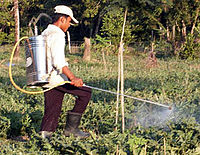
Photo from wikipedia
BACKGROUND Droplets of plant production products sprayed from unmanned aerial spraying system (UASS) applications are prone to drift, threatening non-target crop, human, and environment. There are few studies that have… Click to show full abstract
BACKGROUND Droplets of plant production products sprayed from unmanned aerial spraying system (UASS) applications are prone to drift, threatening non-target crop, human, and environment. There are few studies that have investigated plant bioassay of UASS spray drift, and even fewer when it comes to herbicide application. This work reported a combined field-scale evaluation of spray drift and plant bioassay for a rice herbicide florpyrauxifen-benzyl application using a six-rotor motor UASS under acceptable operating conditions. An artificial rice canopy was built to simulate a practical field application scenario and the soybean was applied to assess the non-targeted crop injury. The effects of nozzle type (droplet size), flight height, and adjuvant on spray deposition, sedimenting drift, airborne drift, and soybean injury were studied to explore the feasibility of UASS herbicide application. RESULTS Under an average wind speed of 1.2-1.5 m·s-1 , reduced flight height, increased droplet size and adding nonionic surfactant resulted in greater deposition, lower drift, and less injury to soybean. Increasing droplet size by changing nozzle was more effective compared with adding adjuvant and reducing the flight height, which offers greater flexibility and can accomplish better spray performance. The correlations between sedimenting drift and soybean injury percentage were highly significant (P<0.01, r>0.96). The calculated buffer distances of 7.7-18.9 m were to varying degrees less than the soybean safety distances of 10.0-20.0 m. CONCLUSION Results of this study provide a reference basis for determining optimum working parameters and establishing buffer zones for the rice herbicide application of UASS.
Journal Title: Pest management science
Year Published: 2022
Link to full text (if available)
Share on Social Media: Sign Up to like & get
recommendations!